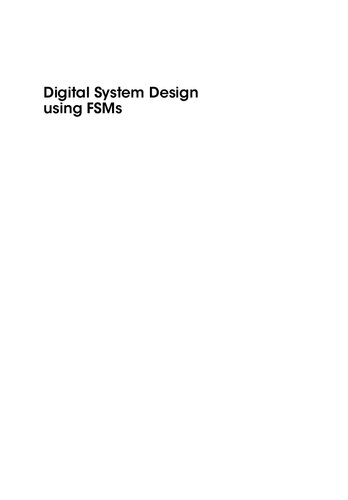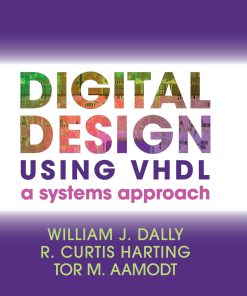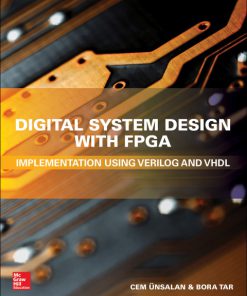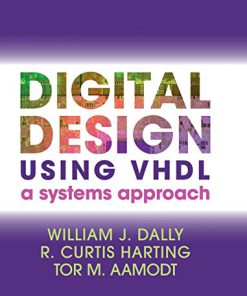Digital System Design using FSMs A Practical Learning Approach 1st Edition by Peter D Minns ISBN 9781119782704 1119782708
$50.00 Original price was: $50.00.$25.00Current price is: $25.00.
Digital System Design using FSMs A Practical Learning Approach 1st Edition by Peter D Minns – Ebook PDF Instant Download/Delivery: 9781119782704 ,1119782708
Full download Digital System Design using FSMs A Practical Learning Approach 1st Edition after payment
Product details:
ISBN 10: 1119782708
ISBN 13: 9781119782704
Author: Peter D Minns
DIGITAL SYSTEM DESIGN USING FSMS
Explore this concise guide perfect for digital designers and students of electronic engineering who work in or study embedded systems
Digital System Design using FSMs: A Practical Learning Approach delivers a thorough update on the author’s earlier work, FSM-Based Digital Design using Verilog HDL. The new book retains the foundational content from the first book while including refreshed content to cover the design of Finite State Machines delivered in a linear programmed learning format. The author describes a different form of State Machines based on Toggle Flip Flops and Data Flip Flops.
The book includes many figures of which 15 are Verilog HDL simulations that readers can use to test out the design methods described in the book, as well as 19 Logisim simulation files with figures. Additional circuits are also contained within the Wiley web folder. It has tutorials and exercises, including comprehensive coverage of real-world examples demonstrated alongside the frame-by-frame presentations of the techniques used.
In addition to covering the necessary Boolean algebra in sufficient detail for the reader to implement the FSM based systems used in the book, readers will also benefit from the inclusion of:
A thorough introduction to finite-state machines and state diagrams for the design of electronic circuits and systems
An exploration of using state diagrams to control external hardware subsystems
Discussions of synthesizing hardware from a state diagram, synchronous and asynchronous finite-state machine designs, and testing finite-state machines using a test-bench module
A treatment of the One Hot Technique in finite-state machine design
An examination of Verilog HDL, including its elements
An analysis of Petri-Nets including both sequential and parallel system design
Suitable for design engineers and senior technicians seeking to enhance their skills in developing digital systems, Digital System Design using FSMs: A Practical Learning Approach will also earn a place in the libraries of undergraduate and graduate electrical and electronic engineering students and researchers.
Digital System Design using FSMs A Practical Learning Approach 1st Edition Table of contents:
1 Introduction to Finite State Machines
1.1 SOME NOTES ON STYLE
2 Using FSMs to Control External Devices
2.1 INTRODUCTION
3 Introduction to FSM Synthesis
3.1 INTRODUCTION
3.2 TUTORIALS COVERING CHAPTERS 1, 2, AND 3
4 Asynchronous FSM Methods
4.1 INTRODUCTION TO ASYNCHRONOUS FSM
4.2 SUMMARY
4.3 TUTORIALS
5 Clocked One Hot Method of FSM Design
5.1 INTRODUCTION
5.2 TUTORIALS ON THE CLOCKED ONE HOT FSM METHOD
6 Further Event‐Driven FSM Design
6.1 INTRODUCTION
6.2 CONCLUSIONS
7 Petri Net FSM Design
7.1 INTRODUCTION
7.2 TUTORIALS USING PETRI NET FSM
7.3 CONCLUSIONS
Appendix A1: Boolean Algebra
A1.1 BASIC GATE SYMBOLS
A1.2 THE EXCLUSIVE OR AND EXCLUSIVE NOR
A1.3 LAWS OF BOOLEAN ALGEBRA
A1.4 EXAMPLES OF APPLYING THE LAWS OF BOOLEAN ALGEBRA
A1.5 SUMMARY
Appendix A2: Use of Verilog HDL and Logisim to FSM
A2.1 THE SINGLE‐PULSE GENERATOR WITH MEMORY CLOCK‐DRIVEN FSM
A2.2 TEST BENCH MODULE AND ITS PURPOSE
A2.3 USING SYNAPTICAD SOFTWARE
A2.4 MORE DIRECT METHOD
A2.5 A VERY SIMPLE GUIDE TO USING THE LOGISIM SIMULATOR
A2.6 USING FLIP‐FLOPS IN A CIRCUIT
A2.7 EXAMPLE SINGLE‐PULSE FSM
A2.8 HOW TO USE THE SIMULATOR TO SIMULATE THE SINGLE‐PULSE FSM
A2.9 USING LOGISIM WITH THE TRUTH TABLE APPROACH
A2.10 SUMMARY
Appendix A3: Counters, Shift Registers, Input, and Output with an FSM
A3.1 BASIC DOWN SYNCHRONOUS BINARY COUNTER DEVELOPMENT
A3.2 EXAMPLE OF A FOUR‐BIT SYNCHRONOUS UP COUNTER WITH T TYPE FLIP‐FLOPS
A3.3 PARALLEL LOADING COUNTERS – USING T FLIP‐FLOPS
A3.4 USING D FLIP‐FLOPS TO BUILD PARALLEL LOADING COUNTERS
A3.5 SIMPLE BINARY UP COUNTER WITH PARALLEL INPUTS
A3.6 CLOCK CIRCUIT TO DRIVE THE COUNTER (AND FSM)
A3.7 COUNTER DESIGN USING DON’T CARE STATES
A3.8 SHIFT REGISTERS
A3.9 DEALING WITH INPUT AND OUTPUT SIGNALS USING FSM
A3.10 USING LOGISIM TO WORK WITH LARGER FSM SYSTEMS
A3.11 SUMMARY
Appendix A4: Finite State Machines Using Verilog Behavioural Mode
A4.1 INTRODUCTION
A4.2 THE SINGLE‐PULSE/MULTIPLE‐PULSE GENERATOR WITH MEMORY FSM
A4.3 THE MEMORY TESTER FSM REVISITED
A4.4 SUMMARY
Appendix A5: Programming a Finite State Machine
A5.1 INTRODUCTION
A5.2 THE PARALLEL LOADING COUNTER
A5.3 THE MULTIPLEXER
A5.4 THE MICRO INSTRUCTION
A5.5 THE MEMORY
A5.6 THE INSTRUCTION SET
A5.7 SIMPLE EXAMPLE: SINGLE‐PULSE FSM
A5.8 THE FINAL EXAMPLE
A5.9 THE PROGRAM CODE
A5.10 RETURNING UNUSED STATES VIA OTHER TRANSITION PATHS
A5.11 SUMMARY
Appendix A6: The Rotational Detector Using Logisim Simulator with Sub‐Circuits
A6.1 USING THE TWO‐STATE DIAGRAM ARRANGEMENT
Bibliography
REFERENCES
FURTHER READING
Index
People also search for Digital System Design using FSMs A Practical Learning Approach 1st Edition:
x-digital systems
fsm-based digital design using the verilog hdl
verilog fsm design
digital electronics finite state machine
digital systems finite state machines
Tags: Peter D Minns, Digital System, FSMs, Learning Approach
You may also like…
Technique - Electronics: Signal Processing
Signals and Systems: A Practical Approach, 2nd Edition D. Sundararajan
Computers - Programming
Data Structures using C: A Practical Approach for Beginners 1st Edition Jagtap
Uncategorized
Computers - Computer Science
Engineering - Electrical & Electronic Engineering
Digital System Design with FPGA: Implementation Using Verilog and VHDL 1st Edition Unsalan
Education Studies & Teaching - Educational Theory
Technique - Electronics: VLSI
Engineering - Electrical & Electronic Engineering
Digital Design Using VHDL A Systems Approach 1st Edition Dally
Medicine - Pharmacology












